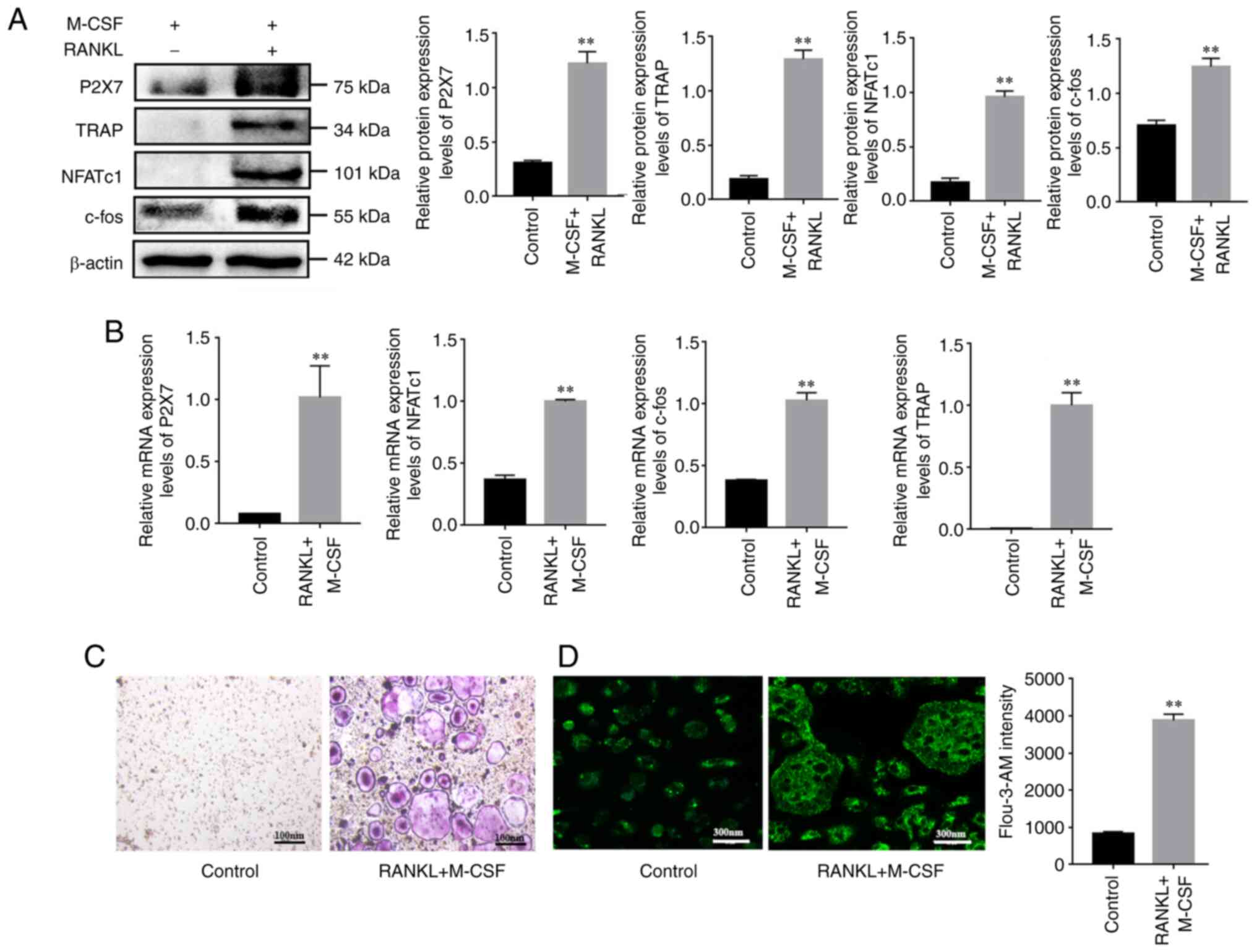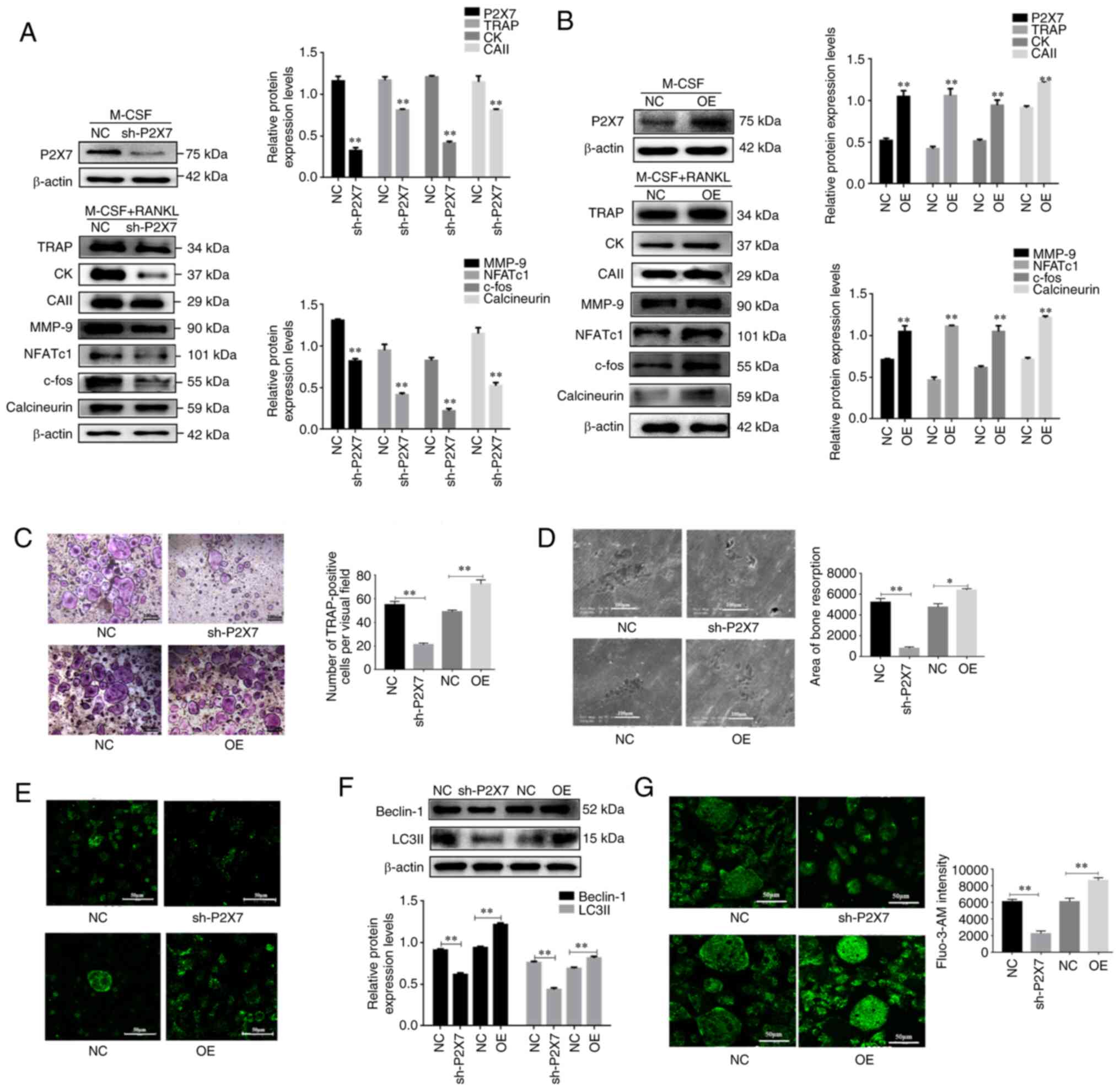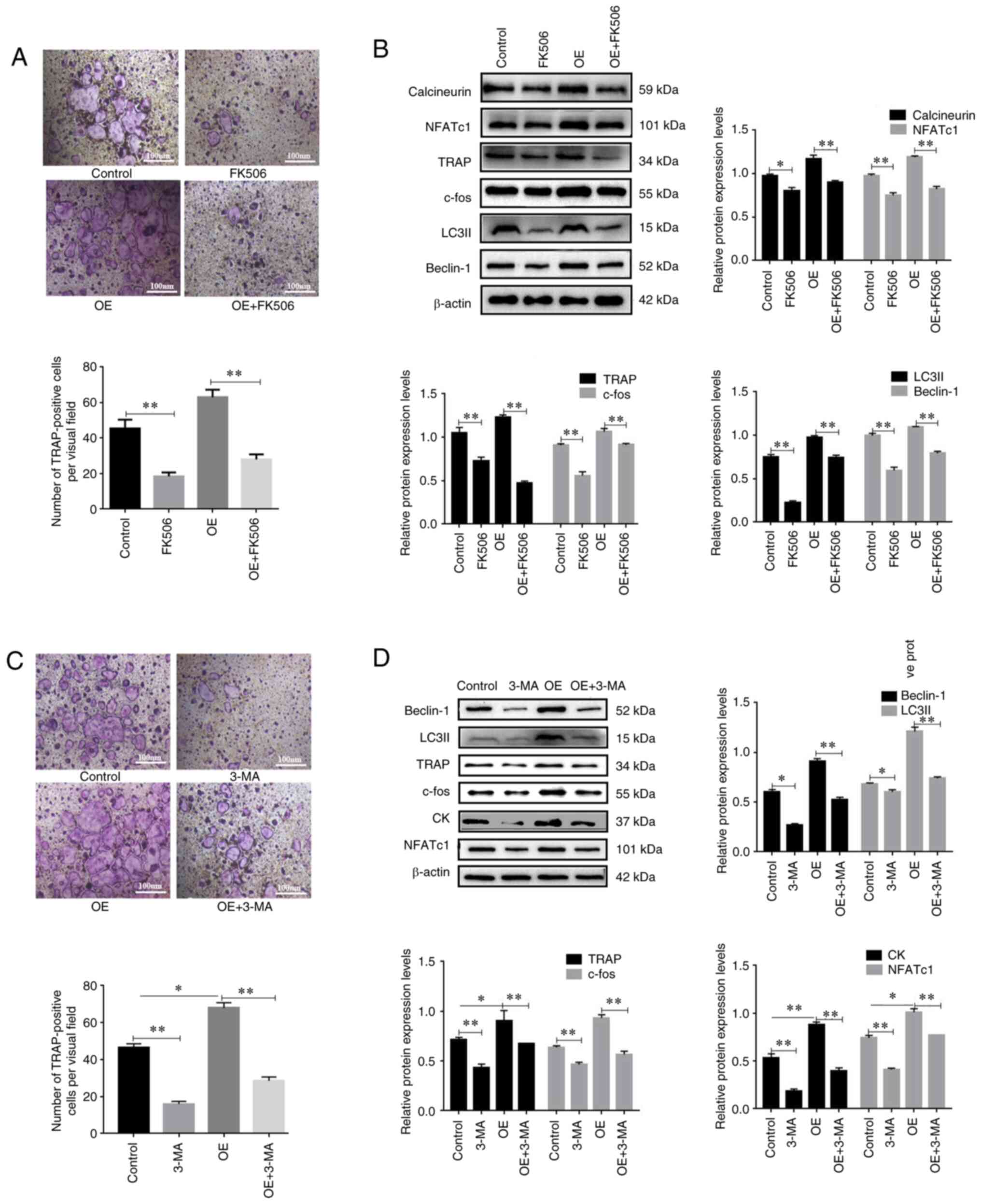|
1
|
Murata K, Fang C, Terao C, Giannopoulou
EG, Lee YJ, Lee MJ, Mun SH, Bae S, Qiao Y, Yuan R, et al:
Hypoxia-sensitive COMMD1 integrates signaling and cellular
metabolism in human macrophages and suppresses osteoclastogenesis.
Immunity. 47:66–79.e5. 2017. View Article : Google Scholar : PubMed/NCBI
|
|
2
|
Alves CH, Farrell E, Vis M, Colin EM and
Lubberts E: Animal models of bone loss in inflammatory arthritis:
From cytokines in the bench to novel treatments for bone loss in
the bedside-a comprehensive review. Clin Rev Allergy Immunol.
51:27–47. 2016. View Article : Google Scholar : PubMed/NCBI
|
|
3
|
Al Faraj A, Shaik AS and Alnafea M:
Intrapulmonary administration of bone-marrow derived M1/M2
macrophages to enhance the resolution of LPS-induced lung
inflammation: Noninvasive monitoring using free-breathing MR and CT
imaging protocols. BMC Med Imaging. 15:162015. View Article : Google Scholar : PubMed/NCBI
|
|
4
|
Nakashima T, Hayashi M, Fukunaga T, Kurata
K, Oh-Hora M, Feng JQ, Bonewald LF, Kodama T, Wutz A, Wagner EF, et
al: Evidence for osteocyte regulation of bone homeostasis through
RANKL expression. Nat Med. 17:1231–1234. 2011. View Article : Google Scholar : PubMed/NCBI
|
|
5
|
Huang XL, Liu C, Shi XM, Cheng YT, Zhou Q,
Li JP and Liao J: Zoledronic acid inhibits osteoclastogenesis and
bone resorptive function by suppressing RANKL-mediated NF-κB and
JNK and their downstream signaling pathways. Mol Med Rep.
25:592022. View Article : Google Scholar : PubMed/NCBI
|
|
6
|
Vega D, Maalouf NM and Sakhaee K: Clinical
review #: The role of receptor activator of nuclear factor-kappaB
(RANK)/RANK ligand/osteoprotegerin: Clinical implications. J Clin
Endocrinol Metab. 92:4514–4521. 2007. View Article : Google Scholar : PubMed/NCBI
|
|
7
|
Zhou S, Yuan X, Liu Q, Zhang X, Pan X,
Zang L and Xu L: BAPTA-AM, an intracellular calcium chelator,
inhibits RANKL-induced bone marrow macrophages differentiation
through MEK/ERK, p38 MAPK and Akt, but not JNK pathways. Cytokine.
52:210–214. 2010. View Article : Google Scholar : PubMed/NCBI
|
|
8
|
Jin H, Yao L, Chen K, Liu Y, Wang Q, Wang
Z, Liu Q, Cao Z, Kenny J, Tickner J, et al: Evodiamine inhibits
RANKL-induced osteoclastogenesis and prevents ovariectomy-induced
bone loss in mice. J Cell Mol Med. 23:522–534. 2019. View Article : Google Scholar : PubMed/NCBI
|
|
9
|
Surprenant A, Rassendren F, Kawashima E,
North RA and Buell G: The cytolytic P2Z receptor for extracellular
ATP identified as a P2X receptor (P2X7). Science. 272:735–748.
1996. View Article : Google Scholar : PubMed/NCBI
|
|
10
|
Orioli E, De Marchi E, Giuliani AL and
Adinolfi E: P2X7 receptor orchestrates multiple signalling pathways
triggering inflammation, autophagy and metabolic/trophic responses.
Curr Med Chem. 24:2261–2275. 2017. View Article : Google Scholar : PubMed/NCBI
|
|
11
|
Jørgensen NR, Syberg S and Ellegaard M:
The role of P2X receptors in bone biology. Curr Med Chem.
22:902–914. 2015. View Article : Google Scholar : PubMed/NCBI
|
|
12
|
Gartland A, Buckley KA, Bowler WB and
Gallagher JA: Blockade of the pore-forming P2X7 receptor inhibits
formation of multinucleated human osteoclasts in vitro. Calcif
Tissue Int. 73:361–369. 2003. View Article : Google Scholar : PubMed/NCBI
|
|
13
|
Ke D, Fu X, Xue Y, Wu H, Zhang Y, Chen X
and Hou J: IL-17A regulates the autophagic activity of osteoclast
precursors through RANKL-JNK1 signaling during osteoclastogenesis
in vitro. Biochem Biophys Res Commun. 497:890–896. 2018. View Article : Google Scholar : PubMed/NCBI
|
|
14
|
DeSelm CJ, Miller BC, Zou W, Beatty WL,
van Meel E, Takahata Y, Klumperman J, Tooze SA, Teitelbaum SL and
Virgin HW: Autophagy proteins regulate the secretory component of
osteoclastic bone resorption. Dev Cell. 21:966–974. 2011.
View Article : Google Scholar : PubMed/NCBI
|
|
15
|
Li Z, Huang Z and Bai L: The P2X7 receptor
in osteoarthritis. Front Cell Dev Biol. 9:6283302021. View Article : Google Scholar : PubMed/NCBI
|
|
16
|
Livak KJ and Schmittgen TD: Analysis of
relative gene expression data using real-time quantitative PCR and
the 2(−Delta Delta C(T)) method. Method. 25:402–408. 2001.
View Article : Google Scholar : PubMed/NCBI
|
|
17
|
Wang N, Agrawal A, Jørgensen NR and
Gartland A: P2X7 receptor regulates osteoclast function and bone
loss in a mouse model of osteoporosis. Sci Rep. 8:35072018.
View Article : Google Scholar : PubMed/NCBI
|
|
18
|
Agrawal A, Buckley KA, Bowers K, Furber M,
Gallagher JA and Gartland A: The effects of P2X7 receptor
antagonists on the formation and function of human osteoclasts in
vitro. Purinergic Signal. 6:307–315. 2010. View Article : Google Scholar : PubMed/NCBI
|
|
19
|
Gartland A, Buckley KA, Hipskind RA, Perry
MJ, Tobias JH, Buell G, Chessell I, Bowler WB and Gallagher JA:
Multinucleated osteoclast formation in vivo and vitro by P2X7
receptor-deficient mice. Crit Rev Eukaryot Gene Expr. 23:243–253.
2003.PubMed/NCBI
|
|
20
|
Ke HZ, Qi H, Weidema AF, Zhang Q,
Panupinthu N, Crawford DT, Grasser WA, Paralkar VM, Li M, Audoly
LP, et al: Deletion of the P2X7 nucleotide receptor reveals its
regulatory roles in bone formation and resorption. Mol Endocrinol.
17:1356–1367. 2003. View Article : Google Scholar : PubMed/NCBI
|
|
21
|
Fujita K, Iwasaki M, Ochi H, Fukuda T, Ma
C, Miyamoto T, Takitani K, Negishi-Koga T, Sunamura S, Kodama T, et
al: Vitamin E decreases bone mass by stimulating osteoclast fusion.
Nat Med. 18:589–594. 2012. View Article : Google Scholar : PubMed/NCBI
|
|
22
|
Takayanagi H, Kim S, Koga T, Nishina H,
Isshiki M, Yoshida H, Saiura A, Isobe M, Yokochi T, et al:
Induction and activation of the transcription factor NFATc1 (NFAT2)
integrate RANKL signaling in terminal differentiation of
osteoclasts. Dev Cell. 3:889–901. 2002. View Article : Google Scholar : PubMed/NCBI
|
|
23
|
Zhang J, Xu H, Han Z, Chen P, Yu Q, Lei Y,
Li Z, Zhao M and Tian J: Pulsed electromagnetic field inhibits
RANKL-dependent osteoclastic differentiation in RAW264.7 cells
through the Ca2+-calcineurin-NFATc1 signaling pathway.
Biochem Biophys Res Commun. 482:289–295. 2017. View Article : Google Scholar : PubMed/NCBI
|
|
24
|
Morrison MS, Turin L, King BF, Burnstock G
and Arnett TR: ATP is a potent stimulator of the activation and
formation of rodent osteoclasts. J Physiol. 511:495–500. 1998.
View Article : Google Scholar : PubMed/NCBI
|
|
25
|
Zhang L, Guo YF, Liu YZ, Liu YJ, Xiong DH,
Liu XG, Wang L, Yang TL, Lei SF, Guo Y, et al: Pathway-based
genome-wide association analysis identified the importance of
regulation-of-autophagy pathway for ultradistal radius BMD. J Bone
Miner Res. 25:1572–1580. 2010. View Article : Google Scholar : PubMed/NCBI
|
|
26
|
Tong X, Min W, Li S, Chen M, Song R, Bian
J, Gu J and Liu Z: Beclin 1 positively regulates
osteoprotegerin-induced inhibition of osteoclastogenesis by
increasing autophagy in vitro. Differentiation. 121:35–43. 2021.
View Article : Google Scholar : PubMed/NCBI
|
|
27
|
Ji Li, Sun Z, Lin Y, Yan Y, Yan H, Jing B
and Han Z: Syndecan 4 contributes to osteoclast differentiation
induced by RANKL through enhancing autophagy. Int Immunopharmacol.
91:1072752021. View Article : Google Scholar : PubMed/NCBI
|
|
28
|
Tong X, Gu J, Song R, Wang D, Sun Z, Sui
C, Zhang C, Liu X, Bian J and Liu Z: Osteoprotegerin inhibit
osteoclast differentiation and bone resorption by enhancing
autophagy via AMPK/mTOR/p70S6K signaling pathway in vitro. J Cell
Biochem. Sep 6–2018.(Epub ahead of print). doi:
10.1002/jcb.27468.
|
|
29
|
Chu B, Chen S, Zheng X, Ye J, Cheng X,
Zhang L, Guo D, Wang P, Hong D and Hong Z: Nepetin inhibits
osteoclastogenesis by inhibiting RANKL-induced activation of NF-κB
and MAPK signalling pathway, and autophagy. J Cell Mol Med.
24:14366–14380. 2020. View Article : Google Scholar : PubMed/NCBI
|
|
30
|
Cejka D, Hayer S, Niederreiter B, Sieghart
W, Fuereder T, Zwerina J and Schett G: Mammalian target of
rapamycin signaling is crucial for joint destruction in
experimental arthritis and is activated in osteoclasts from
patients with rheumatoid arthritis. Arthritis Rheum. 62:2294–2302.
2010. View Article : Google Scholar : PubMed/NCBI
|
|
31
|
Cao B, Dai X and Wang W: Knockdown of
TRPV4 suppresses osteoclast differentiation and osteoporosis by
inhibiting autophagy through Ca2+ -calcineurin-NFATc1
pathway. J Cell Physiol. 234:6831–6841. 2019. View Article : Google Scholar : PubMed/NCBI
|
|
32
|
Sekar P, Huang DY, Hsieh SL, Chang SF and
Lin WW: AMPK-dependent and independent actions of P2X7 in
regulation of mitochondrial and lysosomal functions in microglia.
Cell Commun Signal. 16:832018. View Article : Google Scholar : PubMed/NCBI
|
|
33
|
Ran D, Ma Y, Liu W, Luo T, Zheng J, Wang
D, Song R, Zhao H, Zou H, Gu J, et al: TGF-β-activated kinase 1
(TAK1) mediates cadmium-induced autophagy in osteoblasts via the
AMPK/mTORC1/ULK1 pathway. Toxicology. 442:1525382020. View Article : Google Scholar : PubMed/NCBI
|


















